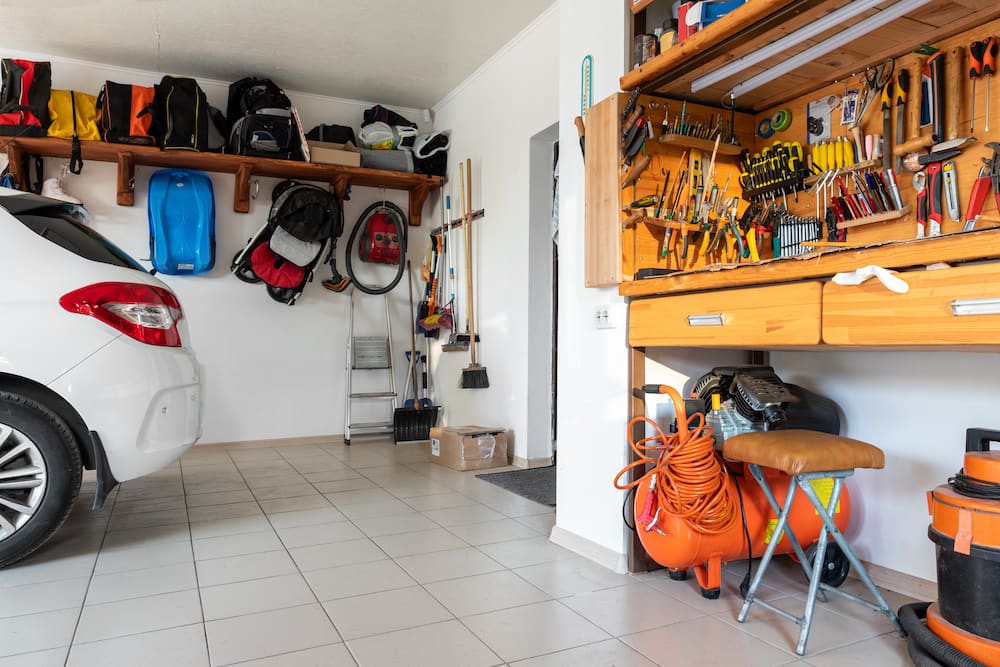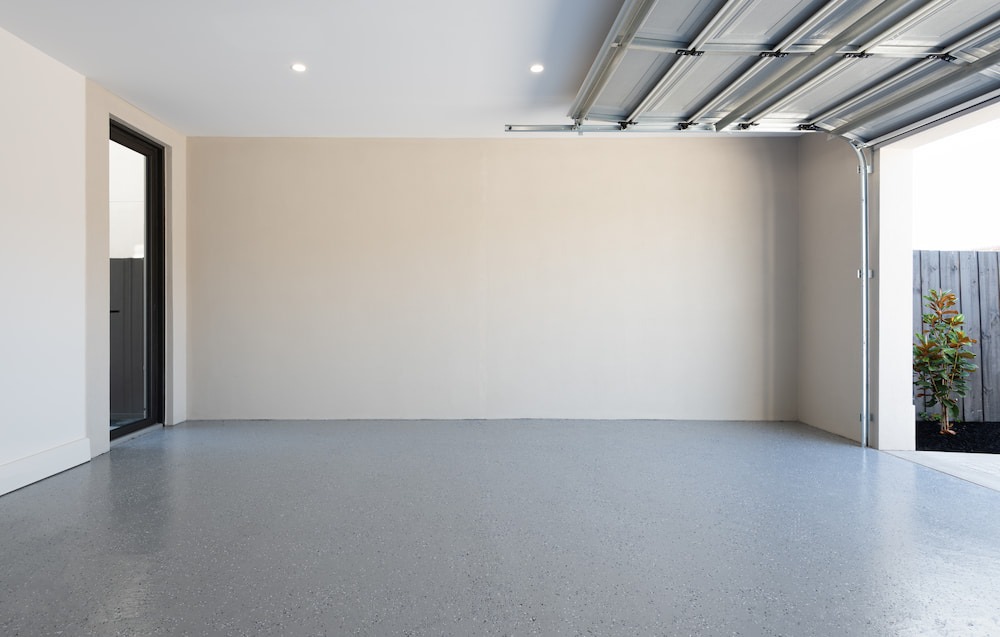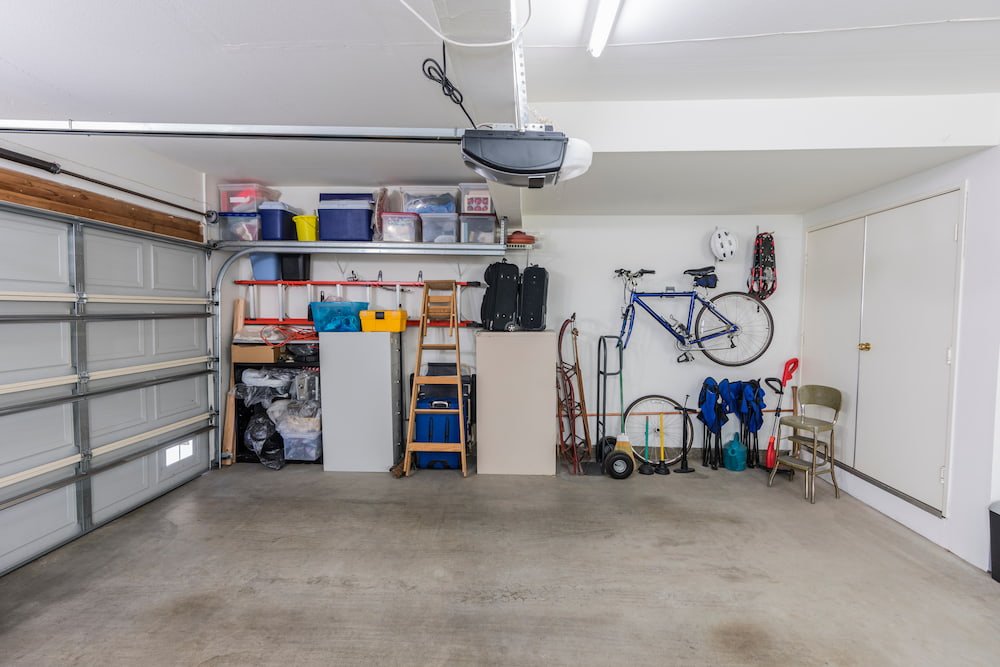How to Declutter and Organize a Garage

How are you using your garage? Do you park cars in it, as intended, or do you use it as a de facto storage unit, or are you somewhere in between?
Often, a garage starts off as car storage, then becomes the overflow for everything that shouldn’t be in the house, and somewhere along the way the garage morphs into “everything storage,” sometimes to the point where the cars end up on the driveway.
If you’re looking to get your cars back into your garage and want to organize it to the point where you can safely fit the sporting equipment, lawn and garden gear, and even have an organized workbench, keep reading.
Get Started by Creating a Plan
Having a plan is always a safe way to start any project.
Whether your garage is already built out or you plan on adding some storage opportunities, now is the time to measure your available space. Throughout this blog, you’ll find some standard measurements for the most common storage pieces you’ll find in a garage. This will allow you to estimate what you have, what you need, and what expenses you might incur.
Think about grouping things together. Automotive stuff in one section, lawn and garden in another, sports gear somewhere else, tools and hardware, seasonal items, etc. If you break it down into these areas, you’ll have a better picture of what you can store and what you’ll need to relocate or downsize.
It’s also important to think about the items you want to keep versus the items you’re willing to get rid of.
Life-saving tip: Consult your spouse on EVERYTHING before continuing in this blog.
Jump in with Decluttering
After you have a general plan, the next step to organizing your garage is to declutter. That’s a fancy way of saying it’s time to get rid of stuff you don’t need. Below are some of the best ideas we’ve found to get rid of unwanted items.
Pro tip: If your garage space is completely overrun with stuff, especially in the case of furniture, collectibles, sports gear and outdoor equipment, etc., it might be a good idea to rent a self-storage unit on a temporary basis. That will at least allow you to take stock of everything you have, what you want to keep, and what you want to get rid of, and give you the space to clean and build out the structures in your garage that will help keep it organized in the future.
How to get rid of almost everything
Part of the decluttering process is to get rid of the stuff you don’t need. There are multiple methods for getting rid of unwanted, or unneeded, items. Here are some of our go-to methods:
Trash: anything that holds no value, is broken, or can be easily (and inexpensively) replaced should go into the garbage. (Be eco-conscious, of course).
Garage sale: make a few extra bucks selling stuff that you don’t need and that holds some intrinsic value.
Dump: after the garage sale, anything that didn’t sell, or that’s too big for the trash, should be taken to the local dump.
Online resale: there are a plethora of sites (Facebook Marketplace, Etsy, Poshmark, etc.) that will act as intermediaries to connect you with buyers.
Donation: Goodwill, arc and others will accept donations of lightly used items. Bonus: you can deduct a percentage of the value of the donated items from your taxes.
Used sports shops: inexpensive sporting goods and equipment are always in high demand, especially when kids are outgrowing things faster than they are wearing them out. Play It Again Sports is one such national franchise.
Curb alerts: take advantage of neighborhood apps like Nextdoor or Craigslist to announce that you’re putting items on the curb. (Pro tip: just leaving an item on the curb with a “free” sign may work, but adding a sign with a made-up price can often encourage a quicker “disappearance,” even if you don’t make any money.)
Recycle: oil can be recycled at most auto parts stores. Salvagers will typically pick up scrap metal such as an old grill or a broken washer/dryer. (More on hazmat materials below.)
Hazardous materials
When you’re cleaning up, you’re likely to come across hazardous materials. While you might not think of them as such, things like pesticides, paint, fluorescent bulbs, batteries, chemicals, bleach and so on should not be thrown in the trash or down the drain.
Pro tip: Fortunately, many communities have designated drop-off locations, or will pick up at your location if you schedule it. Also, keep an eye open for community collection days. Remember, there is usually a fee or a nominal donation associated with these services.
Pay services: of course, there are services that will haul away most of your unwanted items. While some services will accept some items for free (scrap metal for example), the rest usually charge a fee based on the volume of stuff you’re getting rid of.

Cleaning the Garage
Now that the junk is cleaned out, it’s time to get down to actually cleaning your garage.
Start up high and work your way down the walls to get all the cobwebs, dust and dirt. If you’ve got a small storage area in a loft or as part of the gabled section of the garage, it’s a good time to dust off those boxes and reorganize that space to use as additional storage.
Don’t forget to clean off the workbench. Use small bins and containers to collect loose items. Remember to sort them by functionality and label what they’re for: plumbing, electrical, etc.
Save the floor for last. Completely sweep the floor to make sure there are no dirt or salt deposits from last winter. Check that you didn’t brush any nails or screws onto the ground from the workbench. If there are stains, there are several types of concrete cleaners on the market that purport to remove oil and grease, plus other types of stains, even ones that’ve been there for a while. (Read this average homeowner’s review of some of the available concrete cleaning products here.)
Next, check the concrete of the garage floor itself. If it’s starting to crack or shift, you might need to start planning for leveling or repouring the concrete. At least you’ve got everything out of the garage!
Pro tip: Have you regularly checked and serviced your garage door? Here are some garage door maintenance tips, from Home Depot. Little things like making sure the door seals tightly to the ground can save big bucks from energy bills.

Organizing that Garage
Once the cleaning has been completed, it’s time for organizing.
How much storage you’ll actually be able to reclaim is largely dependent on the size of the garage, as well as the vehicle(s) you’re storing. An F-150 and a MINI Cooper just won’t take up the same space.
Once the garage is cleaned out, most of the space you’ll be using will be along the back wall, on one side or the other, opposite the door (doorways are often in the back and doors usually open into the garage). Ideally, this is where you’d also want to incorporate a workbench and/or additional shelving.
Garage storage usually relies on a combination of these storage solutions:
- Workbench
- Cabinets
- Shelving
- Pegboards
- Ceiling Storage
Workbench
A workbench can be a great place to get projects done, but it can quickly turn into a repository for junk or anything that didn’t quite make it into the house.
Because of that, make sure there are a lot of additional storage options throughout the garage to remove the temptation to use the workbench for random storage.
If you’re looking to build or purchase a workbench, here are a couple of things to consider:
A good workbench should have a sturdy surface (about 3 inches thick) and be close to a power source. Workbenches are usually 28 to 36 inches deep (2-1/2 to 3 ft). The width will largely depend on your available space, and can be anywhere from 4 ft. to 8 ft., with 6 to 7 being the standards. Remember to factor in space for ancillary items like a table saw or garage fridge.
Use your workbench in conjunction with a pegboard and/or tool chest to ensure the right tool for whatever job presents itself and can be found quickly.
Cabinets
If you’re adding storage cabinets, those are going to be a foot to a foot-and-a-half deep. If you are using cabinets near ground level (don’t put them directly on the ground to avoid water damage), make sure you can open them with a vehicle inside the garage. You can also put shelves at eye level. Don’t put them too high, as items can be easily forgotten, or so low that they interfere with car doors or walking areas.
Pro tip: While garage cabinets might look more garage-appropriate with a metal or industrial finish, you can certainly repurpose old kitchen cabinets.
If you have a parts storage cabinet, great. If not, improvise with stackable, disposable Tupperware or resealable cans (remember those Chock Full O’ Nuts coffee cans at your grandparents’ house?). Remember to label the sides, not the tops.
Note: If you’ve got kids, a lockable cabinet is a must-have to keep them safe from dangerous tools and/or chemicals.
Shelving
Whether you’re using a commercial wire-frame design, a heavy-duty plastic version, or building your own wooden ones, shelves are a great alternative to cabinets. Why? They are easier to configure (and reconfigure), you don’t have to open doors to use them, you can see exactly what’s on them, and you can go higher on the wall.
Industrial/heavy-duty shelves are usually 1-1/2 ft. deep, and 6 ft. tall. Widths can vary, although 4 ft. is a fairly common size. To fully utilize the height of the shelving unit, make sure to anchor the shelf to the wall.
Shelving options often include baskets and additional hooks, which can greatly expand storage capacity and functionality.
Pegboards
Pegboards can be used for all types of storage. Most commonly associated with tool storage, pegboards can also be used for sporting goods, exercise equipment, gardening tools and much more. While the pegs used to be just hooks, modern pegboard accessories include cups and bins, tool organizers and more.
Ceiling
The ceiling is often an underutilized storage area. We all know that hooks can be used to store bicycles, but you can also suspend additional shelving from the ceiling, or, our favorite hack, add overhead rails that accommodate storage bins. This is especially helpful for camping and similar seasonal activities that require a lot of equipment. Just make sure you’re not interfering with the garage door.
Other tips
Just like elsewhere in the home, it’s important to keep similar items together. While decorative baskets might work in the living room, they might not be durable enough for the garage. Instead, consider mesh bags for sports equipment because they’re breathable and easy to haul around. Trash bins can be repurposed to hold tall garden implements or even scraps of metal or wood.

FAQs:
Q: How big are garages?
A: A standard one-car garage is about 12 ft. wide and somewhere between 20 and 24 ft. deep. Each additional car will add between 8 and 10 ft. to the initial width, meaning a large 2-car garage may be about 20 ft. wide by 20 to as much as 24 ft. deep. A standard height for a finished garage is usually 7 or 8 ft. More info about garages can be found here.
Q: What are the 5 steps to organize a garage?
A: Organizing a garage can be completed in 5 steps. Use the tips above to maximize your space and minimize your effort.
1) Start with a plan
2) Get rid of unwanted items
3) Clean top to bottom
4) Plan your storage options
5) Keep it organized
Q: How do you categorize things in your garage?
A: The more you can categorize the things in your garage, the easier it will be to keep them organized and find them when you need them. Group similar items together: automotive, lawn and garden, sports, recycling, and seasonal items are the most frequent considerations. Keep items that are used most frequently in easy-to-access locations, and seasonal or rarely used items in less-accessible locations.
Pro tip: Give kids special storage areas to keep their items, to help them learn responsibilities, and to keep their items out of the way.
Final Thoughts on Garage Organization
We ask our garages to do a lot. For the most part, if we stay ahead of the mess, we can keep them clean and organized. But if the mess gets out of hand, don’t be afraid to ask for help. Services like HomeAdvisor have entire sections devoted to professional garage organizers.
Of course, you can use our storage location finder to get a great deal on the self-storage you need to complete your garage organization project.







